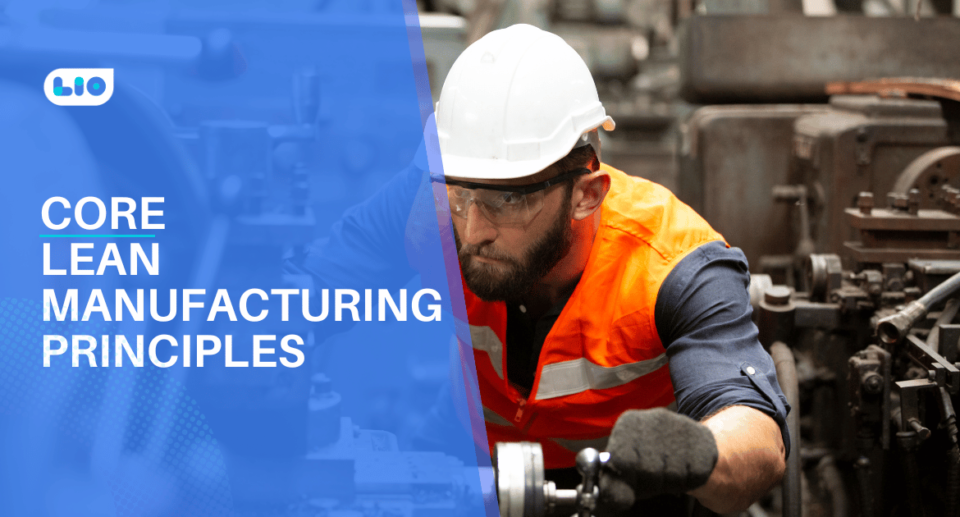Understanding the Manufacturing Industry
Gaurav Singh Rawat
- June 29, 2024
- 14 Min Read

The manufacturing industry is a cornerstone of economic development and industrialization worldwide. It encompasses the transformation of raw materials into finished products through various processes, machinery, and human labor. Manufacturing plays a crucial role in creating tangible goods that meet consumer needs and drive economic growth.
What is Manufacturing
Manufacturing is the process of transforming raw materials, components, or parts into finished goods that meet a customer’s expectations or specifications. It involves the use of labor, machinery, tools, and chemical or biological processing or formulation.
Manufacturing encompasses a wide range of activities, from small-scale production using hand tools to large-scale operations with advanced machinery and automated systems. This sector plays a crucial role in the global economy by creating tangible products, driving innovation, and generating employment.
Modern manufacturing often incorporates cutting-edge technologies like robotics, artificial intelligence, and the Internet of Things to enhance efficiency and productivity.
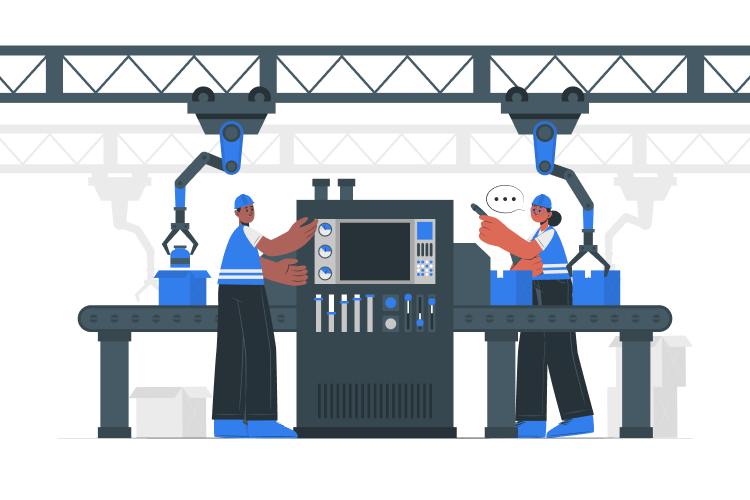
Innovate Your Production
Stay ahead in the manufacturing industry by adopting innovative digital solutions. Discover how to streamline operations and improve quality.
History of Manufacturing
The history of manufacturing is a fascinating journey that traces the evolution of human production methods from ancient times to the present day. This narrative encompasses three pivotal eras: the pre-Industrial Revolution period, characterized by manual craftsmanship and small-scale production; the Industrial Revolution, which ushered in mechanization and mass production; and the modern manufacturing era, defined by advanced technologies and global supply chains.
Each phase brought significant changes to production processes, economic structures, and societal norms. Understanding this history provides valuable insights into the technological advancements, economic shifts, and social transformations that have shaped our world, highlighting the crucial role manufacturing has played in human progress and development.
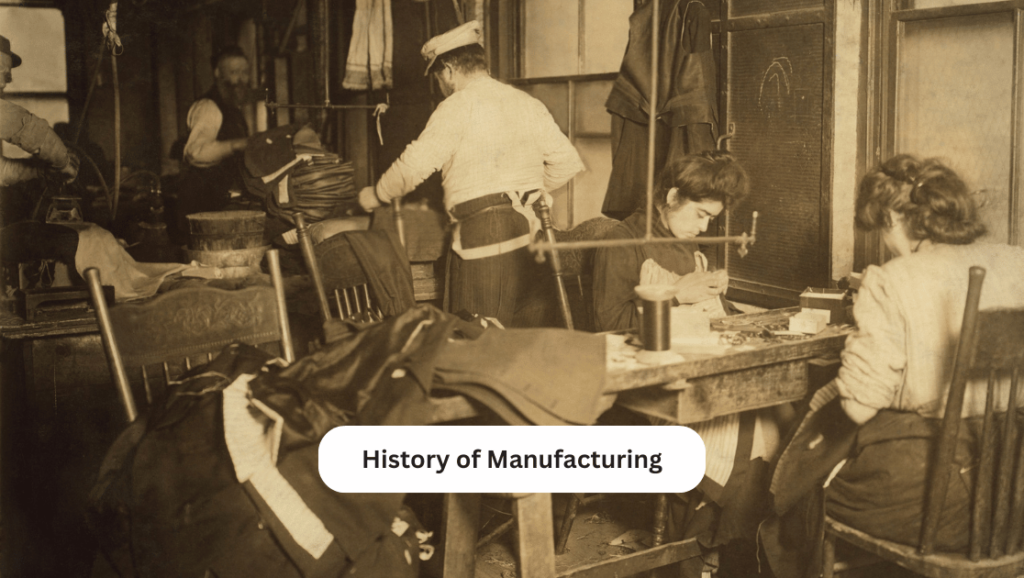
Pre-Industrial Revolution
Before the Industrial Revolution, manufacturing was primarily a manual process carried out by skilled artisans and craftsmen. This period, often referred to as the pre-industrial era, saw the production of goods in small workshops or homes, using basic tools and techniques. Key characteristics of this era include:
– Manual Labor: Most manufacturing tasks were performed by hand, often with the assistance of simple tools.
– Cottage Industries: Production was decentralized, with many goods being made in small, family-run workshops or homes.
– Guilds: These were associations of artisans and craftsmen that regulated the quality, production methods, and trade of specific goods.
– Agrarian Economy: The economy was predominantly agricultural, with manufacturing playing a secondary role.
– Limited Production: The scale of production was small, and goods were often made to order or for local markets.
Industrial Revolution
The Industrial Revolution, which began in the late 18th century in Great Britain, marked a significant shift in manufacturing processes. This period saw the introduction of machinery, leading to mass production and the growth of factories. Key developments during this era include:
– Mechanization: The introduction of machines like the spinning jenny, power loom, and steam engine revolutionized production processes.
– Factory System: Manufacturing moved from small workshops to large factories, centralizing production and increasing efficiency.
– Urbanization: The rise of factories led to the growth of cities as people moved from rural areas to urban centers in search of work.
– Mass Production: The use of machinery allowed for the mass production of goods, significantly lowering costs and increasing availability.
– Technological Innovations: Innovations in transportation (e.g., railroads, steamships) and communication (e.g., telegraph) facilitated the growth of industries and markets.

Revolutionize Production
Join the digital revolution in manufacturing. Implement smart technologies to enhance productivity, reduce errors, and drive growth.
Modern Manufacturing
Modern manufacturing has evolved significantly from its early days, incorporating advanced technologies and processes to increase efficiency and productivity. Key features of modern manufacturing include:
– Automation and Robotics: The use of automated systems and robots has streamlined production processes, reducing the need for manual labor and increasing precision.
– Computer-Integrated Manufacturing (CIM): This involves the integration of computer systems to control the entire production process, from design to manufacturing to quality control.
– Industry 4.0: The latest phase in manufacturing, characterized by the use of digital technologies such as the Internet of Things (IoT), artificial intelligence (AI), and big data to create smart factories.
– Sustainability: Modern manufacturing places a strong emphasis on sustainable practices, including the use of renewable energy sources, recycling, and waste reduction.
– Global Supply Chains: Manufacturing today is often part of a global supply chain, with different components being produced in various parts of the world and assembled in another.
Different Types of Manufacturing
Manufacturing processes can be broadly categorized into several types based on the methods and techniques used to produce goods. Here are the main types of manufacturing processes:
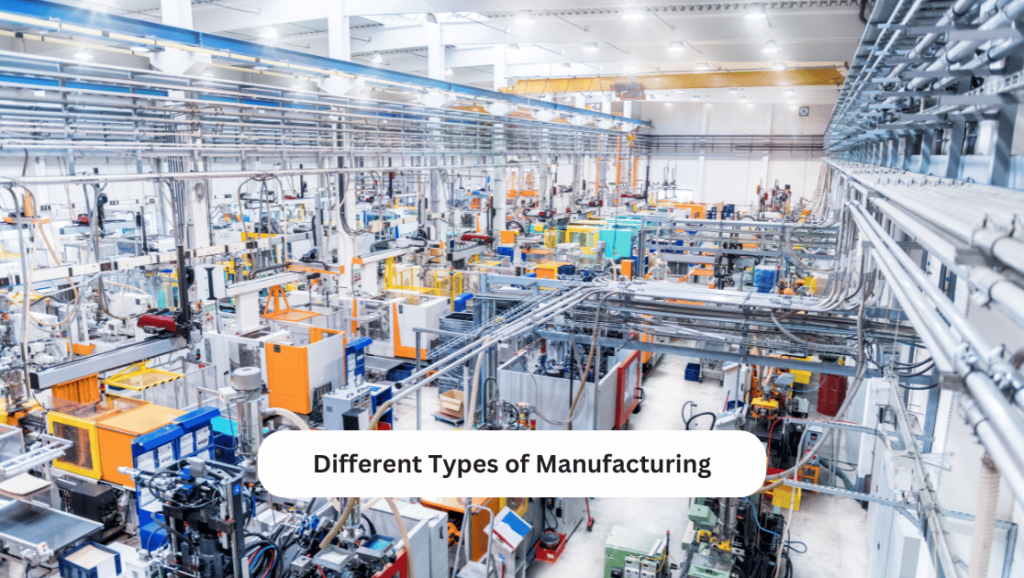
Repetitive Manufacturing
Repetitive manufacturing involves producing the same product repeatedly, often on an assembly line. This method is ideal for high-volume production with minimal variations. The production line can run continuously, making it efficient for products with stable demand, such as automotive parts or consumer electronics.
Discrete Manufacturing
Discrete manufacturing is similar to repetitive manufacturing but allows for more variation in the products. It involves the production of distinct items that can be individually counted. This method is suitable for industries that require frequent changes in product design, such as the automotive and electronics industries.
Job Shop Manufacturing
Job shop manufacturing is used for custom or small-batch production. It involves a flexible setup where products are made to order based on specific customer requirements. This method is common in industries that produce specialized machinery, custom parts, or prototypes.
Batch Process Manufacturing
Batch process manufacturing involves producing goods in batches. Each batch goes through the production process before the next batch begins. This method is useful for industries that require flexibility in production, such as food processing, pharmaceuticals, and chemicals.
Continuous Process Manufacturing
Continuous process manufacturing runs 24/7, producing goods without interruption. This method is used for products that require a continuous flow of materials, such as oil refining, chemical production, and water treatment. It is similar to repetitive manufacturing but typically involves liquids, gases, or powders.

Digitalize Your Factory
Take the first step towards a digital factory. Implement our solutions to streamline operations and increase productivity.
3D Printing (Additive Manufacturing)
3D printing, or additive manufacturing, involves creating products layer by layer from digital models. This method is highly flexible and allows for the production of complex and customized items. It is used in various industries, including aerospace, medical devices, and consumer goods.
Lean Manufacturing
Lean manufacturing focuses on maximizing productivity while minimizing waste. It involves continuous improvement practices to enhance efficiency and reduce costs. This method is widely adopted across various industries to improve quality and streamline operations.
Casting and Molding
Casting and molding involve shaping materials by pouring them into molds. This method is used for producing metal parts, plastic components, and other items that require precise shapes. Common techniques include die casting, sand casting, and injection molding.
Forming and Machining
Forming processes involve shaping materials through deformation, such as forging and stamping. Machining processes, on the other hand, involve removing material to create the desired shape, such as milling, turning, and drilling. These methods are essential for producing metal parts and components.
Joining and Assembly
Joining processes involve combining two or more parts to create a final product. Common techniques include welding, soldering, and adhesive bonding. Assembly processes involve putting together various components to form a complete product, such as assembling cars or electronic devices.
What is the Manufacturing Industry?
The manufacturing industry refers to enterprises engaged in the mechanical, physical, or chemical transformation of materials, substances, or components into new products. It involves the use of power-driven machines and materials-handling equipment to create goods on a large scale.
Manufacturing industries convert inputs like raw materials, components, and parts into finished products that meet customer expectations.
Types of Manufacturing Industries
Manufacturing industries can be classified based on various criteria, including the raw materials used, the nature of the products, ownership, and the scale of operations. Here are the main types of manufacturing industries:
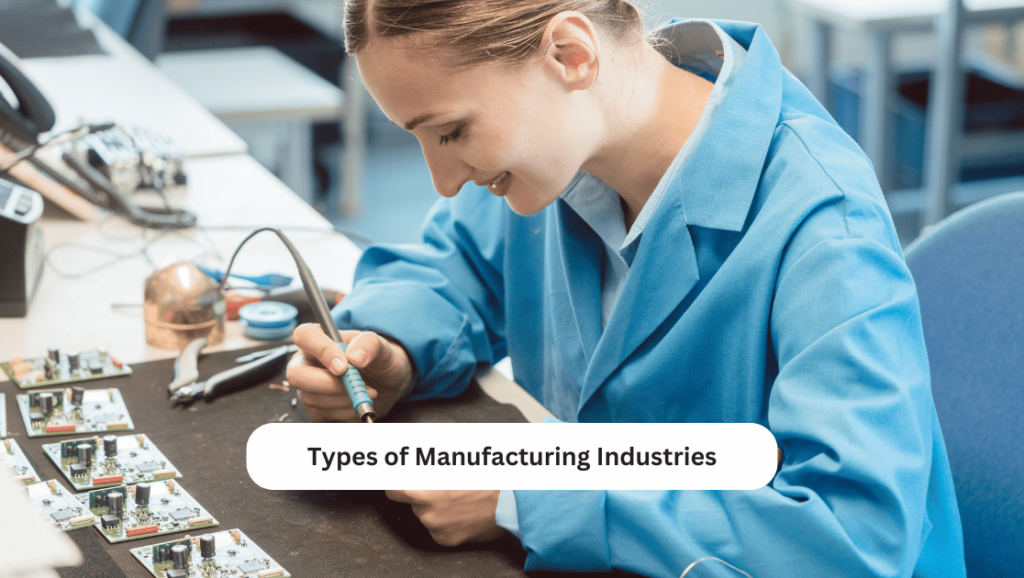
Based on Raw Materials Used
– Agro-based Industries: These industries use agricultural products as raw materials. Examples include the cotton, sugar, jute, and food processing industries.
– Mineral-based Industries: These industries use minerals as raw materials. Examples include the iron and steel, aluminum, and cement industries.
– Forest-based Industries: These industries utilize forest products. Examples include the paper, timber, and furniture industries.
Based on the Nature of Products
– Consumer Goods Industries: These industries produce goods that are directly used by consumers, such as clothing, electronics, and food products.
– Capital Goods Industries: These industries produce machinery and equipment used by other industries, such as manufacturing machinery, construction equipment, and industrial tools.
– Intermediate Goods Industries: These industries produce goods that are used as inputs by other industries, such as steel, textiles, and chemicals.
Based on Ownership
– Public Sector Industries: Owned and operated by the government. Examples include Steel Authority of India Limited (SAIL) and Oil & Natural Gas Corporation (ONGC).
– Private Sector Industries: Owned and operated by private individuals or corporations. Examples include Tata Motors and Reliance Industries.
– Joint Sector Industries: Owned and operated jointly by the government and private sector. Examples include Maruti Suzuki.
– Cooperative Sector Industries: Owned and operated by a group of individuals or cooperatives. Examples include Amul (dairy cooperative).

Future-Proof Manufacturing
Prepare your manufacturing business for the future with our comprehensive digital transformation strategies. Start today to stay competitive.
Based on Scale of Operations
– Small-scale Industries: These industries operate on a small scale with limited capital investment and workforce. Examples include local bakeries and handicraft producers.
– Medium-scale Industries: These industries operate on a medium scale with moderate capital investment and workforce. Examples include small manufacturing units and regional food processing plants.
– Large-scale Industries: These industries operate on a large scale with significant capital investment and workforce. Examples include automobile manufacturing plants and large textile mills.
Based on Production Process
– Repetitive Manufacturing: Involves producing the same product repeatedly, often on an assembly line. Suitable for high-volume production with minimal variations.
– Discrete Manufacturing: Produces distinct items that can be individually counted. Suitable for industries requiring frequent changes in product design.
– Job Shop Manufacturing: Used for custom or small-batch production. Suitable for specialized machinery, custom parts, or prototypes.
– Batch Process Manufacturing: Produces goods in batches, with each batch going through the production process before the next begins.
– Continuous Process Manufacturing: Runs 24/7, producing goods without interruption. Suitable for products requiring a continuous flow of materials, such as chemicals and oil refining.
Types of Manufacturing Companies
Manufacturing companies can be broadly categorized based on the type of products they manufacture, the processes they use, and the industries they serve. Here are the main types of manufacturing companies:
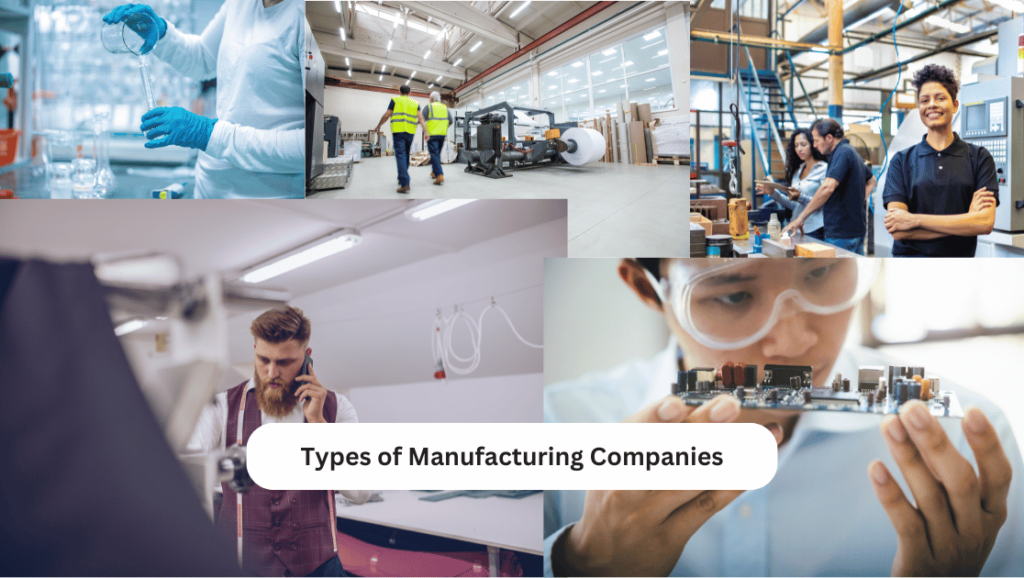
Food and Beverage Manufacturing
– Food Manufacturing: Companies that process raw agricultural products into consumable food items. Examples include bakeries, dairy product manufacturers, and meat processing plants.
– Beverage Manufacturing: Companies that produce drinks, both alcoholic and non-alcoholic. Examples include breweries, distilleries, and soft drink manufacturers.
Chemical Manufacturing
– Basic Chemicals: Companies that produce basic chemicals used in various industries, such as petrochemicals, fertilizers, and industrial gases.
– Specialty Chemicals: Companies that produce chemicals for specific applications, such as pharmaceuticals, agrochemicals, and cleaning agents.
Textile and Apparel Manufacturing
– Textile Mills: Companies that produce fibers, yarns, and fabrics.
– Apparel Manufacturing: Companies that produce clothing and accessories from textiles. This includes cut-and-sew operations and knitting mills.
Electronics and Electrical Equipment Manufacturing
– Consumer Electronics: Companies that produce electronic devices for personal use, such as smartphones, televisions, and computers.
– Industrial Electronics: Companies that produce electronic equipment for industrial applications, such as control systems and automation equipment.
Automotive and Transportation Equipment Manufacturing
– Automotive Manufacturing: Companies that produce vehicles, including cars, trucks, and motorcycles.
– Aerospace Manufacturing: Companies that produce aircraft, spacecraft, and related components.
– Shipbuilding: Companies that construct ships and other marine vessels.
Metal and Machinery Manufacturing
– Primary Metal Manufacturing: Companies that produce basic metal products, such as steel, aluminum, and copper.
– Fabricated Metal Products: Companies that produce metal products by cutting, bending, and assembling processes.
– Machinery Manufacturing: Companies that produce industrial machinery and equipment, such as engines, turbines, and construction machinery.
Plastics and Rubber Manufacturing
– Plastics Manufacturing: Companies that produce plastic products through processes like injection molding and extrusion.
– Rubber Manufacturing: Companies that produce rubber products, such as tires, hoses, and belts.
Wood, Paper, and Printing Manufacturing
– Wood Products Manufacturing: Companies that produce wood products, such as lumber, plywood, and furniture.
– Paper Manufacturing: Companies that produce paper and paper products, such as packaging materials and stationery.
– Printing and Related Support Activities: Companies that provide printing services and related activities, such as bookbinding and prepress services.
Pharmaceutical and Medical Device Manufacturing
– Pharmaceutical Manufacturing: Companies that produce medications and other pharmaceutical products.
– Medical Device Manufacturing: Companies that produce medical devices and equipment, such as surgical instruments, diagnostic machines, and implants.
How can Lio help Manufacturing Businesses??
Lio can be a valuable tool for manufacturing businesses, offering several features that can streamline operations and improve efficiency. Here’s how Lio can help in manufacturing:
Customizable Workflows
Lio allows manufacturers to create custom workflows tailored to their specific production processes. This flexibility enables businesses to digitize and optimize their unique manufacturing procedures.

Transform Manufacturing Now
Embrace the future of manufacturing with Lio. Improve your supply chain, enhance product quality, and stay competitive.
Real-Time Data Tracking
With Lio, manufacturers can track production data in real-time. This includes monitoring inventory levels, production output, machine performance, and other key metrics, providing valuable insights for decision-making.
Quality Control Management
Lio can be used to create quality control checklists and inspection forms. This ensures that quality standards are consistently met throughout the production process.
Inventory Management
The platform allows for efficient tracking of raw materials, work-in-progress, and finished goods inventory. This helps in maintaining optimal stock levels and preventing production delays due to stock-outs.
Equipment Maintenance Scheduling
Lio can be used to create maintenance schedules for manufacturing equipment. This helps in preventing unexpected breakdowns and maximizing equipment uptime.
Production Planning and Scheduling
Manufacturers can use Lio to plan and schedule production runs, allocate resources, and manage work orders efficiently.
Supply Chain Management
Lio can help in managing supplier information, purchase orders, and delivery schedules, ensuring a smooth flow of materials into the production process.
Mobile Accessibility
Lio’s mobile-friendly platform allows factory floor workers to access and update information on the go, improving communication and responsiveness.

Conclusion
The manufacturing industry stands as a cornerstone of global economic development, driving innovation, creating employment, and producing essential goods for society. From its humble beginnings in pre-industrial workshops to the advanced smart factories of today, manufacturing has undergone significant transformations, adapting to technological advancements and changing market demands.
Understanding the diverse types of manufacturing processes, industries, and companies provides valuable insights into the sector’s complexity and importance. As we move forward, the industry continues to evolve, embracing new technologies like automation, AI, and IoT to enhance efficiency and productivity. Challenges such as sustainability, skilled labor shortages, and global competition are shaping the future of manufacturing.
For businesses in this sector, leveraging modern tools and software solutions like Lio can significantly improve operations, from inventory management to quality control. As the manufacturing landscape continues to change, staying informed and adaptable will be key to success in this dynamic and vital industry.
Frequently Asked Questions (FAQs)
What is the difference between discrete manufacturing and process manufacturing?
Discrete manufacturing produces distinct, countable items (e.g., cars, furniture), while process manufacturing creates products in bulk quantities that can’t be easily separated (e.g., chemicals, food products).
How is the Internet of Things (IoT) impacting the manufacturing industry?
IoT is enabling smart factories by connecting machines, allowing real-time data collection, predictive maintenance, and improved efficiency in production processes.
What is additive manufacturing and how is it changing the industry?
Additive manufacturing, or 3D printing, is creating objects layer by layer. It’s revolutionizing prototyping, customization, and small-batch production in manufacturing.
How does reshoring affect the manufacturing sector?
Reshoring, the practice of bringing manufacturing back to the home country, can lead to job creation, shorter supply chains, and increased control over production quality.
What is the role of robotics in modern manufacturing?
Robotics in manufacturing automates repetitive tasks, increases precision, improves safety, and enhances productivity in factories.
How does the circular economy concept apply to manufacturing?
The circular economy in manufacturing focuses on minimizing waste and maximizing resource efficiency through recycling, reusing, and remanufacturing products and materials.
What is the significance of digital twins in manufacturing?
Digital twins are virtual replicas of physical products or processes, allowing manufacturers to simulate, predict, and optimize performance before implementation.

